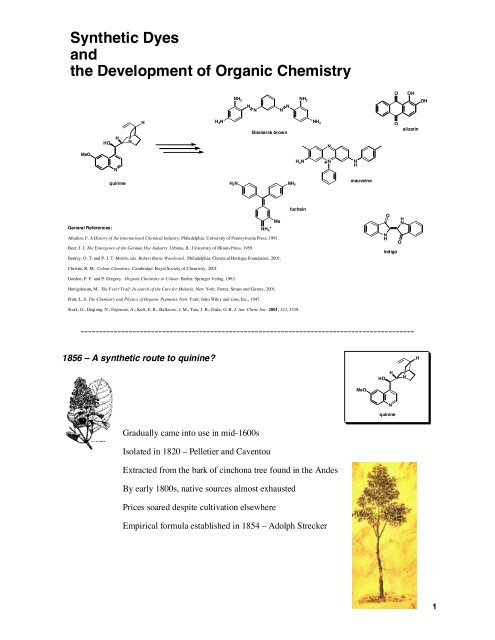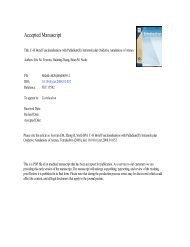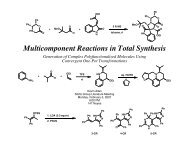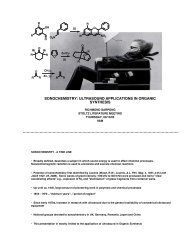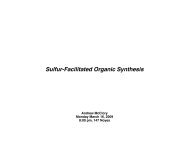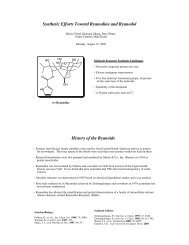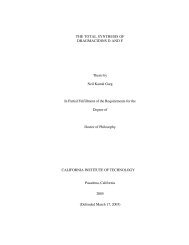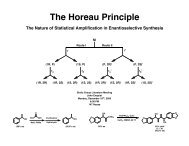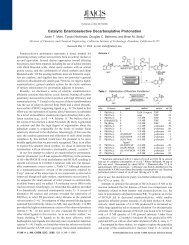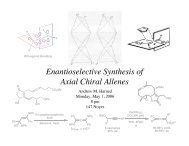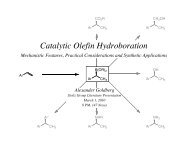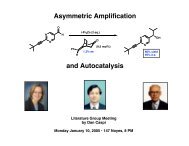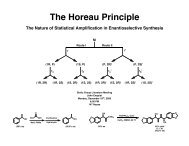Synthetic Dyes and the Development of Organic Chemistry
Synthetic Dyes and the Development of Organic Chemistry
Synthetic Dyes and the Development of Organic Chemistry
Create successful ePaper yourself
Turn your PDF publications into a flip-book with our unique Google optimized e-Paper software.
1856 – Perkin's Easter vacationFormula, but not structure <strong>of</strong> quinine knownPerkin attempted oxidation:2C 10 H 13 N + 3[O]KCr 2 O 4H 2 SO 4C 20 H 24 N 2 O 2 + H 2 OquinineWilliam Henry Perkin, age 14HHN[O]HOHNMeONExperiment resulted in v. impure brown powder, but Perkin tried to assess whe<strong>the</strong>r <strong>the</strong> oxidationwas general:NNH 2+KCr 2 O 4H 2SO 4black sludgeEtOH, refluxH 2 NNNHNH 2Meimpuritiespurple crystals = "aniline purple," later mauveine--------------------------------------------------------------------------------------------------------1857 – An industry beganCurrent syn<strong>the</strong>tic dyes were unsuitable, but dem<strong>and</strong> was highO 2 NOHNO 2 yellowmade from phenolnot lightfastHNNO 2picric acidOHNOOONmurexideHNNHOO - NH 4+reddish-purplereasonably light-resistantapplication complex <strong>and</strong> expensivesyn<strong>the</strong>size from urea <strong>and</strong> nitric acidPerkin left school, fa<strong>the</strong>r risked fortuneSuccess required establishment <strong>of</strong> large scale organic chemicals industryRaw materials to make aniline needed on large scale: benzene, nitric acid, anilinePerkin's sketch <strong>of</strong> Perkin <strong>and</strong> Sons dye factory2
1800-1845 – Coal tar <strong>and</strong> Justus Liebig set <strong>the</strong> stageIn late 1700s coal distilled for tar; after 1812, illuminating gas became desirable, excess coal taraccumulatedLiebig one <strong>of</strong> <strong>the</strong> premier educators <strong>of</strong> all timeFresenius, Erlenmeyer, Kekulé, Wurtz...Small links between industry <strong>and</strong> chemistry establishedAugust Wilhelm H<strong>of</strong>mann began to analyze coal tar extractsH<strong>of</strong>mann establishes Royal College <strong>of</strong> <strong>Chemistry</strong> in Engl<strong>and</strong> *Liebig's lab in Giessen-----------------------------------------------------------------------------------------------------------H 2 NNH1856-1867 – Post-mauveine developments2Concious search for new dyes – fuchsin found by Emanuel VerguinTriphenylmethine dyes enable systematic syn<strong>the</strong>sis <strong>of</strong> new compounds – H<strong>of</strong>mannProduction <strong>of</strong> mauveine stopped after ten yearsNH 2+rosaniline or fuchsin1867 – value <strong>of</strong> dyes had tripled since 1862 despite price dropsN N NH 2Price per kilo <strong>of</strong> raw materials <strong>and</strong> dyesaniline yellow1862 1867+ HNbenzene 5 fr 70 crosaniline 300 fr 30 fr- O 3 SNHNHaniline blueNOHNNNN[O]H + SO 3 NH 4SO 3 NH 4NOHNNmalachite green3
1858 – Peter Griess <strong>and</strong> <strong>the</strong> azo dyesMore Germans in Engl<strong>and</strong>YNONH 2- ONONH 22 diazotization azo couplingOtto Witt, Heinrich Caro <strong>and</strong> Carl Alex<strong>and</strong>er MartiusVersatile chemistry exploitedHNO 2+-Y - H 2N ONHONOONONO-H + N + N+ H 2 ONOYNONH 2HNNOClN ONNOH+ N O H +N N NH 2NNOH 2+aniline yellowAzo dyes today account for 60-70% <strong>of</strong> dyes used in textile applicationsnitrite anionnitrious acidnitrosoacidium ionnitrosonium cation-H 2 OPeter GriessN N H 2 NNH 2chrysoidineN + NpH important in diazotization aswell as azo couplingdinitrogen trioxidenitrosyl chlorideincreasing acidity----------------------------------------------------------------------------------------------------------1869 – Alizarin, <strong>the</strong>n decline for Engl<strong>and</strong> <strong>and</strong> FranceO OHOalizarinOH1868 – Graebe <strong>and</strong> Liebermann deduce structurePerkin <strong>and</strong> Sons first commercial producers:Class <strong>of</strong> carbonyl dyes – anthraquinones1869 - 1 ton1870 - 40 tons1871 - 220 tonsMadderGraebe <strong>and</strong> Liebermann:Caro, Perkin:OBr 2OBrBrOH2SO4OSO 3 HOOOONaOH, ![O]OBrOOHOHOSO3HSO3HOOHOHBrOOOOBut Engl<strong>and</strong> was on <strong>the</strong> decline:H<strong>of</strong>mann departs in 1865Not enough trained chemistsMinimal state fundingBusiness complacencyLittle cultivation <strong>of</strong> scientific inquiryFrance too:Not enough raw materialsLoss <strong>of</strong> Alsace-Lorraine in 1871Patents for products, not processesPrivate labs did not supply enough trained chemists4
German industry on <strong>the</strong> riseBayerAGFAKalle,HöchstBASFCIBA, S<strong>and</strong>ozDecentralization – lack <strong>of</strong> investment necessitated imitation, competition among small statesPatent situation – laws difficult to enact, foreign technology not protected, competition increasedGeography – raw materials, transportation in Rhein river valleyEducation – <strong>the</strong> Liebig tradition supplied fresh ideas, trained chemistsUnification in 1871 – Patent Act <strong>of</strong> 1876 arrived at <strong>the</strong> right timeBusiness – ties between industry <strong>and</strong> universities established quickly--------------------------------------------------------------------------------------------------------Education – Universities <strong>and</strong> <strong>the</strong> Technische Hochschule1809 Univeristy <strong>of</strong> Berlin – model for a modern university:SeminarsSemestersVernacularPr<strong>of</strong>essional training, productive citizensLiebig's pedagogical model:Close relationship with pr<strong>of</strong>essor, whose enthusiasm evoked admiration <strong>and</strong> loyaltyFull enthusiasm for studies – 6 days/wk, 12-15 hrs/dayCompetitive atmosphere among students"ample opportunities <strong>of</strong> witnessing, in a comparatively short time, a vast variety <strong>of</strong>processes which are being constantly carried on in an institution consisting <strong>of</strong> a greatnumber <strong>of</strong> experimentalists" (H<strong>of</strong>mann, 1849)1860s – glut <strong>of</strong> doctoral students led to technische hochschule: *Proximity to state centersTies with state <strong>and</strong> industryIncluded education in o<strong>the</strong>r fieldsStimulated improvements at universities (v. similiar by 1900)Ties with pr<strong>of</strong>essors highly sought after by companies5
1870s – Heinrich Caro exemplifies industrial <strong>and</strong> academic cooperationAs director <strong>of</strong> research at BASF, Caro tirelessly fostered ties with academics1868 – Graebe <strong>and</strong> Liebermann consult Caro regarding alizarin1873 – Adolf von Baeyer <strong>and</strong> Caro collaborate on research programThey discover eosinMartius at Agfa discovers secret formula with <strong>the</strong> help <strong>of</strong> H<strong>of</strong>mannHeinrich Caro1876 – Caro stymied again with chrysoidine by Martius <strong>and</strong> H<strong>of</strong>mann *1876 – Griess supplied Caro with samples from azo coupling reactions1878 – Emil <strong>and</strong> Otto Fischer (under von Baeyer) solve structure <strong>of</strong> triphenylmethine dyes, butonly with help from CaroHOBrOBrOBrCO 2 HBrEosinA. W. H<strong>of</strong>mannAdolf von BaeyerEmil Fischer------------------------------------------------------------------------------------------1870-1890 – Rise <strong>of</strong> <strong>the</strong> industrial research laboratory <strong>and</strong> <strong>the</strong> Bayer exampleResearch labs enabled acceleration <strong>of</strong> research by consolidating resourcesTeamsFacilitiesAcademically trained scientists in management positionsBayer was slower to innovate than o<strong>the</strong>r major german firmsBy 1882, a full research staff was still not established1884 –Duisberg enables Bayer to compete with AgfaCarl DuisbergDuisberg spontaneously evolves into a research directorPrimitive labs replaced with Duisberg design <strong>of</strong> new building, layout adopted almost universally*Also quality control, library, conferences, product testingIn 1896, 1 in 70 dyes approved for productionBy 1900, 1 in 200 dyes marketedca. 1905, 1 in 300 dyes marketedNH 2SO 3 NaNNN N NH 2benzopurpurin 4BSO 3NaBayer laboratories after Duisberg6
Back to <strong>the</strong> mosquitoH1918 – Paul Rabe takes quinotoxine to quinineMeOONHMeOHOHNNN1944 Woodward <strong>and</strong> Doering's planquinotoxineHONRabeONHHNHMeOMeOHOHNNquinotoxineOhomeroquineneHON7-hydroxyisoquinoline----------------------------------------------------------------------------------------Woodward's Quinotoxine syn<strong>the</strong>sisNHHONCH2OpiperidineMeOHHONNMeOH/NaOMe220 °C, 10h64%HONMeOON7-hydroxyisoquinoline1. H 2, PtOAcOH2. Ac 2O, MeOH95% (for 2 steps)HONOH 2 Raney NiquantHOONOHONEtOH/NaOEtEtONO68%mixture <strong>of</strong> isomersH36% cis recrystallizedHONHNOMeI, K 2 CO 3EtOHNHNO1. 60% NaOH40 °C2. KOCNHCrO 3N NH2O1. 0.1 N HCl!2. AgO, H 2 SHNHEtOOH90%EtOOH42%HOOHquantHO HOhomeroquineneOOEt1. EtOH, HCl2.BzCl, K 2CO 396%EtOHHNOPhMeONNaOEt, !MeOEtOOOHHNOPh6 N HCl, !50% (2 steps)quinotoxineON9
ConclusionsONHHOHNMeOMeONNquinotoxineWhile dye chemistry is a limited field, it facilitated <strong>the</strong> development <strong>of</strong> organicchemistry, chemical industry, chemical education as we know <strong>the</strong>m today.10


